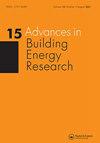Identification of criteria for the selection of buildings with elevated energy saving potentials from hydraulic balancing-methodology and case study
IF 2.5
Q2 CONSTRUCTION & BUILDING TECHNOLOGY
引用次数: 2
Abstract
ABSTRACT Hydraulic balancing is key to ensure proper operation of the heating system. When the heating system is not hydraulically balanced, heat is unevenly distributed across dwellings resulting in a wide temperature spread, overheating, and consequently, wastage of energy. In this paper, we study to which extent hydraulic imbalance affects the thermal energy demand of buildings. Furthermore, key variables and interactions that influence the thermal performance of buildings are identified. In the first part, a dataset, including building features, boiler capacity and energy consumption of 49 multifamily buildings in Geneva (Switzerland), is analysed. Applying regularization regression, we find that higher variation in indoor temperature leads to larger energy consumption. Buildings constructed before 1980, having large boiler capacity and large heated floor area, are more likely to be hydraulically imbalanced and to consume more energy, indicating higher energy saving potential from hydraulic balancing. The second part consists of a case study of four multifamily buildings in Geneva where hydraulic balancing was implemented. We monitor data associated with temperature levels and energy consumption and find that hydraulic balancing significantly reduces the temperature spread avoiding overheating. The yearly energy savings by hydraulic balancing at an outdoor temperature of 0°C are estimated at 9% in Geneva.确定从水力平衡中选择节能潜力高的建筑物的标准——方法和案例研究
摘要液压平衡是确保供暖系统正常运行的关键。当供暖系统没有液压平衡时,热量在住宅中的分布不均匀,导致温度分布广泛、过热,从而浪费能源。在本文中,我们研究了水力不平衡在多大程度上影响建筑物的热能需求。此外,还确定了影响建筑物热性能的关键变量和相互作用。在第一部分中,分析了日内瓦(瑞士)49栋多户建筑的建筑特征、锅炉容量和能耗数据集。应用正则化回归,我们发现室内温度变化越大,能耗越大。1980年以前建造的建筑,锅炉容量大,受热面积大,更容易发生水力不平衡,消耗更多的能源,这表明水力平衡具有更高的节能潜力。第二部分是对日内瓦四栋多户建筑的案例研究,其中实施了液压平衡。我们监测了与温度水平和能耗相关的数据,发现液压平衡显著降低了温度分布,避免了过热。日内瓦的室外温度为0°C时,液压平衡每年可节省9%的能源。
本文章由计算机程序翻译,如有差异,请以英文原文为准。
求助全文
约1分钟内获得全文
求助全文
来源期刊

Advances in Building Energy Research
CONSTRUCTION & BUILDING TECHNOLOGY-
CiteScore
4.80
自引率
5.00%
发文量
11
 求助内容:
求助内容: 应助结果提醒方式:
应助结果提醒方式:


